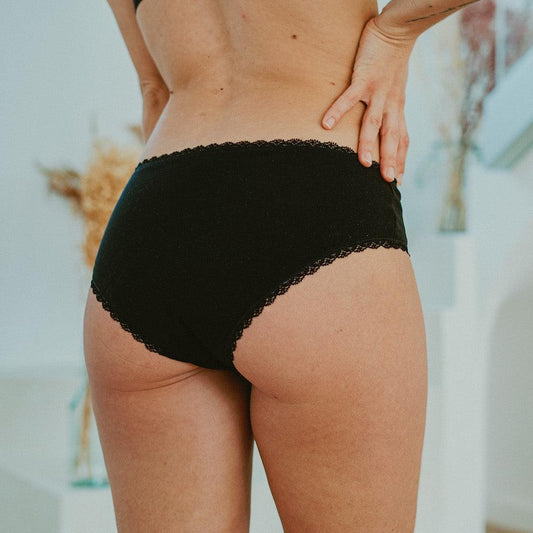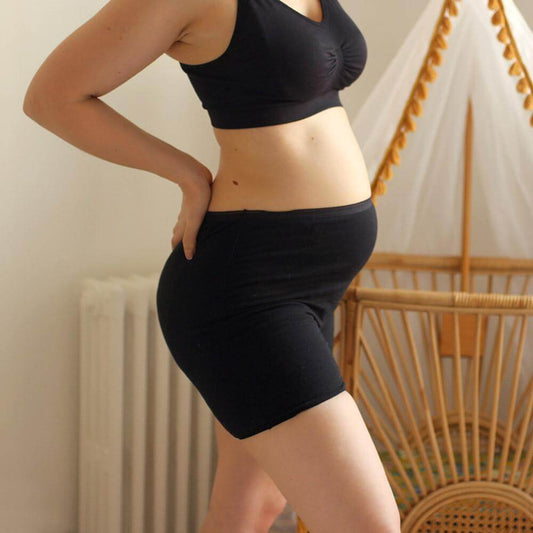Les varices vulvaires ? Nous sommes d’accord, ce n’est pas un terme qui donne envie d’en savoir plus. Pourtant, étant donné que les varices vulvaires (aussi appelées varices pelviennes, vaginales ou périnéales) sont assez fréquentes chez la femme enceinte, il nous semblait important d’aborder le sujet ! Diagnostic, symptômes, causes, traitement… Elia vous dit tout sur le sujet !
Qu’est-ce qu’une varice vulvaire ?
Les varices vulvaires font partie des désagréments que peut connaître la femme enceinte lors de sa grossesse. Si elles disparaissent en général après l’accouchement ou à l’arrêt de l’allaitement, il est parfois nécessaire de suivre un traitement pour les soigner ! Concrètement, il s’agit de varices au niveau de la vulve, causées par une insuffisance veineuse, comme pour les varices “classiques” au niveau des jambes. La zone peut alors être douloureuse et gonflée, en raison de la dilatation des vaisseaux sanguins. Toutefois, elles ne concernent que 10% des femmes enceintes, et en majorité les primipares, pour qui c’est la première grossesse.
Comment reconnaître les varices vulvaires ou périnéales ?
Les varices pelviennes sont le terme utilisé pour englober les varices sur la vulve et du périnée.
Les varices vulvaires sont plus faciles à détecter : les lèvres sont gonflées, voire douloureuses, avec des traits bleutés ou violacés, qui disparaissent à la pression du doigt.
Les varices du périnée sont plus difficiles à reconnaître, car elles se manifestent principalement par des douleurs dans le bas-ventre, et peuvent être confondues avec d’autres symptômes de la grossesse.
Quels sont les symptômes des varices vulvaires pendant la grossesse ?
Loin d’imaginer des conséquences handicapantes, sont, la plupart du temps, asymptomatiques. Mais certaines peuvent constater un gonflement des lèvres, voire souffrir de douleurs, de démangeaisons ou de gêne en marchant. Les rapports sexuels peuvent également être plus douloureux.
A quel mois de grossesse les varices vulvaires apparaissent-elles ?
Les femmes ayant déjà des antécédents d’insuffisance veineuse pourront être potentiellement sujettes à ces désagréments dès le début de la grossesse, mais en général, ces dernières apparaissent plutôt en fin de grossesse ou à partir du deuxième trimestre.
Quelles sont les causes des varices ?
Les varices, qu’elles soient situées sur la vulve ou les jambes, sont causées par une insuffisance veineuse. Dans le cas de la varice vulvaire ou de la varice vaginale, cette insuffisance veineuse résulte des fluctuations hormonales qui ont lieu durant la grossesse.
Les hormones (œstrogènes et progestérone) ont tendance à favoriser la dilatation des veines, ce qui entraîne un ralentissement du flux sanguin et donc une insuffisance veineuse. Les veines situées sur le pubis sont sensibles aux changements hormonaux. De plus, le poids du bébé qui augmente au fil de la grossesse exerce une pression sur la zone pelvienne.
Établir un diagnostic
Puisqu’il s’agit d’une affection relativement bénigne et parfois asymptomatique, l’établir relève avant tout d’une observation clinique de la zone par un professionnel de santé (sage-femme ou gynécologue). La varice se reconnaît par des dilatations violacées ou bleutées, qui disparaissent sous la pression.
Une personne touchée par une varice vulvaire est souvent aussi concernée par des varices aux jambes. Le médecin qui réalise l’examen devra donc vérifier si la patiente présente des varices sur les membres inférieurs, et si elle a des antécédents de thrombose ou d’insuffisance veineuse.
Si besoin, il est possible de solliciter l’avis d’un phlébologue pour réaliser une écho-doppler, et bénéficier de ce double regard pour confirmer le diagnostic.
Comment se passe le traitement des varices vulvaires à la grossesse ?
Les varices disparaissent souvent de manière spontanée. Si ce n’est pas le cas, il faudra envisager un soin des varices pelviennes en bouchant les varices pour empêcher le retour veineux vers les veines de la vulve. On parle d’embolisation des varices.
Si des malformations venaient à apparaître en post-partum, le médecin pourrait envisager de passer par une chirurgie des veines.
Comment prévenir l’apparition de varices vulvaires ?
Elles pourront être évitées en suivant ces conseils :
- Ne pas hésiter à porter des bas, collants ou chaussettes de contention, qui peuvent être prescrits afin de bénéficier d’une prise en charge par la Sécurité Sociale ;
- Éviter de croiser les jambes ou de maintenir la même position trop longtemps (rester assise plusieurs heures, ou au contraire debout en position statique) ;
- Porter des vêtements amples et non serrés, surtout près de l’entre-jambes, du bassin et des cuisses ;
- Réaliser des massages drainants : en partant des pieds et en remontant jusqu’en haut des jambes (les massages lymphatiques sont tout à fait appropriés dans ce cas !) ;
- Continuer à pratiquer une activité physique (sport doux comme le yoga, marche quotidienne, vélo, pilates, etc) ;
- Placer des cales sous les deux pieds en bout de lit, de manière à surélever les jambes pendant le sommeil ;
- Appliquer du froid : par exemple, un tissu en coton mis au congélateur, en guise de “patch” froid pour soulager la brûlure et diminuer la taille de la veine ;
- Éviter les douches brûlantes et les bains chauds.
Est-ce que les varices vulvaires compliquent l’accouchement ?
De manière générale, elles ne compliquent pas l’accouchement, et la femme pourra tout à fait accoucher sans risque pour la santé par voie basse. Seule exception, elles sont trop douloureuses ou imposantes, le gynécologue peut envisager une césarienne afin d’éviter le risque d’hémorragie variqueuse.
La FAQ de la varice vulvaire
Est-ce que les varices vulvaires et pelviennes surviennent en même temps ?
Les varices pelviennes est le terme pour englober les varices vulvaires et périnéales. En général, en cas de varices au niveau du périnée, le risque de contracter des varices vulvaires sera élevé.
Comment faire pour retirer des varices vulvaires ?
Dans la majorité des cas, elles disparaissent spontanément après la grossesse. Aussi, la prévention reste la meilleure des solutions pour éviter d’être touchée par les varices vulvaires pendant la grossesse ! Si toutefois les varices ne partent pas, il faudra envisager une embolisation des varices près de pelvis, afin d’empêcher le reflux sanguin vers les veines de la vulve.
Quelles sont les causes des varices vulvaires chez les femmes enceintes ?
Les varices vulvaires chez les femmes enceintes sont principalement causées par une insuffisance veineuse. Pendant la grossesse, les changements hormonaux, notamment l'augmentation des œstrogènes et de la progestérone, favorisent la dilatation des veines, ce qui ralentit la circulation sanguine. La pression exercée par le poids du bébé sur la région pelvienne aggrave cette congestion veineuse, ce qui peut entraîner l'apparition de varices au niveau de la vulve. Les antécédents d'insuffisance veineuse ou de varices sur les jambes peuvent également augmenter le risque de développer des varices vulvaires au cours de la grossesse.










